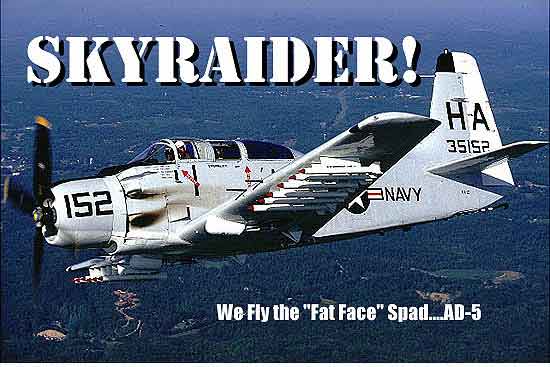 |
AD-5 Skyraider: Dipping
into the Horsepower Pool |
PAGE FOUR The R-3350, by the way has an unusual sound to it. It has a vaguely "mechanical" undertone that at idle almost overpowers exhaust noise. It's probably the gears in the reduction unit whirling away, but it initially sounds a little like a piece of farm equipment. We leave the wings folded while maneuvering out towards the open area near the taxiway. It would be bad form to unfold the wings and hammer a Cessna flat. The Navy has a thing about accidental wing folding, as evidenced by their folding controls. While the wings are folded, a large, flat door in the middle of the console between the seats is open and the cover pokes the pilot in the leg reminding him not to takeoff with the wings folded. Duh!. To close the door requires pushing and turning a control handle in a well on the console. If it isn't in the right place, you can't close the door. As the wings slowly drop into place, a red bar about as big around as your thumb which has been sticking out of the leading edge is retracted flush indicating the wing pins have slid into place. I check to see if the console door closes flush. I check the red pin again. Looks okay. Still.... The Skyraider, as with most taildragging carrier aircraft, has a locking, full swivel tailwheel. When the control on the left console behind the throttle is engaged, the tailwheel is locked straight forward which supposedly makes the airplane track straight. It doesn't. The airplane will still wander. If it's unlocked, the tailwheel swivels and you have to stay right on top of it with brakes. Although the airplane was easy to taxi, I was surprised how often
I had to tap a brake to keep it from turning into the crosswind.
I should have made better mental note of that characteristic. At the end of the runway, we did a Q and A type of check list. I'd hold it up and call out the item and Doc would confirm it in place. Wings down and locked? Check! Aux Hydraulic pump, off? Check! Boost pump, on? Check! We ran down down the list including making certain the trim was where it had to be: 1 1/2 units right rudder, zero elevator for this load, and balanced ailerons as per the last time the airplane flew. We held the last two items, the tailwheel lock and mag check, until out on the runway and powered up ready to launch. It's recommended that power be brought up to field barometric pressure, about 30 inches, just prior to takeoff to clear the plugs. The mags are checked at the same time. One of my eternal impressions of that first takeoff was that, for some reason, the airplane just seemed "light." I can't explain that. It didn't hunker down on the gear like a Mustang or Bearcat, which don't change character until the power and speed are well up. As soon as the power was up on the Skyraider and we were accelerating, I could feel the airplane getting light, the oleos coming off the stops. Of course we probably didn't weigh more than 15,000 pounds (!!) so we really were light. As soon as the runway started to fall away, I saw the safety catch on the landing gear handle magically disappearing into the cockpit rail, letting the gear handle be moved into the up position. As soon as we were going uphill solidly, I made the first recommended power reduction to 38 inches. Then, as the gear locked up, the power came back to 35 inches, the prop at 2600 rpm, where it stayed while we climbed up stairs. I didn't think too much about it at the time, but since the engine was designed to run on 130/145 octane fuel, with an alternate of 100/130, there was no way with only 100LL fuel available we could have reached the normal takeoff power of 56-58 inches without detonation setting in. As it was, we were using only 45 inches for takeoff where the military recommended 48 inches just for climb. Lower power settings may be partially because of fuel limitations, but also because there's no reason to push an engine you actually own. None of us are 22 years old and burning up Uncle Sam's motor and fuel. Like I said before, I was just faking the role, not living it. At 58 inches, the Skyraider must be a real hoss on takeoff. We ran upstairs at 1800-2,000 fpm at 120 knots indicated. Spad pilots have told me when fully loaded, they were happy to get even half that. As soon as the airplane was off the runway, I knew I liked it. The ailerons especially. Although they have conventional cables running to them, the controls are hydraulically boosted with the boost being perfectly balanced. The result is a set of slick controls that on all axis are on a par with, and actually better, meaning lighter and quicker, than, most prop fighters. Despite its huge size, the airplane is absolutely willing to dance. Motoring along above a broken cloud deck, the green of North Carolina peeking through and sufficing for Viet Nam, I realized I may have been looking at similar scenery, but it had to look different knowing "they" were down there. It had to be different when at any time 37 mm AAA could be bursting around you. Still, it was a golden opportunity and I again silently thanked Hank Avery. |
